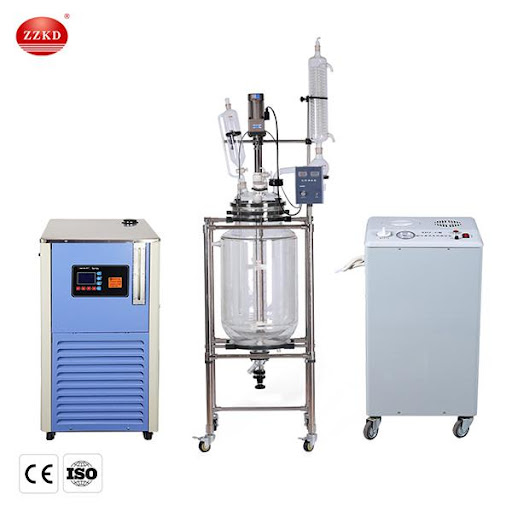100L jacketed glass reactor is a type of laboratory equipment used for chemical reactions, mixing, and other processes involving substances in liquid or gaseous form.The space between the inner vessel and the outer jacket can be filled with a temperature-controlling fluid (heating or cooling liquid) to regulate the temperature of the contents inside the reactor.
100L refers to the capacity of the reactor, which can be loaded with 100L of reaction medium. The capacity of our jacketed glass reactor is 1L, 2L, 5L, 10L, 20L, 50L, 100L,etc.
The structure of 100L jacketed glass reactor
100L jacketed glass reactor consists of several components that work together to facilitate chemical reactions, mixing, and temperature control. Here’s an overview of thestructure of a jacketed glass reactor:
Inner Glass Vessel: The inner glass vessel is the main chamber where the chemical reaction takes place. It is made of high-quality borosilicate glass, which is resistant to chemical corrosion and thermal stress. The transparent nature of the glass allows researchers to visually monitor the progress of reactions.
Stirring System: Inside the glass vessel, there is a stirring system that includes a motor, a stirring shaft, and an impeller or paddle. This system ensures thorough mixing of reactants, solvents, or other substances, enhancing reaction efficiency.
Reactor Cover: The reactor cover is typically made of the same high-quality borosilicate glass as the vessel. It provides access to the interior of the reactor and includes ports for adding reactants, monitoring the reaction, and connecting instrumentation.
Ports and Connections: The reactor cover and body have various ports and connections to accommodate different functions. These include ports for:
Adding reactants or solvents
Installing a thermometer or temperature sensor
Connecting a condenser or reflux setup
Attaching a pressure relief valve
Installing a sampling port
Temperature Control System: A temperature control system is connected to the outer jacket to maintain a desired temperature within the reactor. This system can involve a heating or cooling fluid that circulates through the jacket, allowing precise temperature regulation.
Pressure Control: jacketed glass reactors may also have a pressure control system that allows researchers to regulate the pressure inside the reactor. This is particularly important for reactions that involve volatile or reactive substances.
Condenser: In reactions that involve vaporization and condensation, a condenser can be attached to the reactor setup. The condenser helps to cool and condense any vaporized substances back into liquid form, preventing loss of volatile components.
Safety Features: Depending on the design and purpose of the reactor, safety features such as pressure relief valves, rupture discs, and temperature alarms might be incorporated to ensure safe operation.
100L jacketed glass reactor application
100L Jacketed glass reactors are commonly used in research laboratories, pilot plants, and industrial settings for a variety of applications, including:
Chemical Synthesis: They are used to carry out chemical reactions under controlled temperature and pressure conditions.
Process Optimization: Researchers can use these reactors to test and optimize reaction conditions before scaling up to larger industrial processes.
Reaction Monitoring: The transparent glass walls allow researchers to visually monitor the progress of reactions in real time.
Mixing and Stirring: The reactors are equipped with stirring mechanisms that ensure thorough mixing of reactants.
Temperature Control: The jacket around the reactor can be connected to temperature control systems, allowing precise control of the reaction temperature.
Crystallization and Precipitation: The controlled environment of the reactor is often used for the controlled formation of crystals and precipitation of solids from solutions.
Distillation and Reflux: jacketed glass reactors can be used for distillation and reflux processes.
Jacketed glass reactors are versatile tools that provide a controlled environment for a wide range of chemical processes. The glass construction allows for visibility of reactions while the jacketing enables temperature control, making them valuable assets in laboratory research and development.





